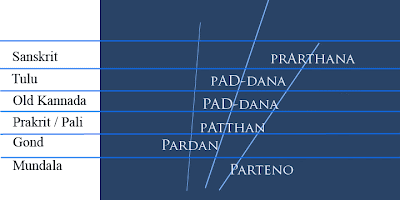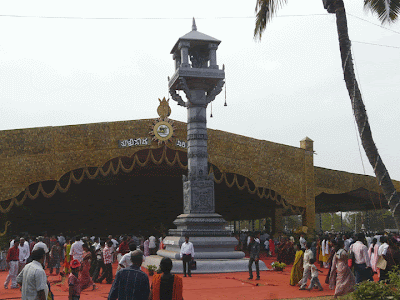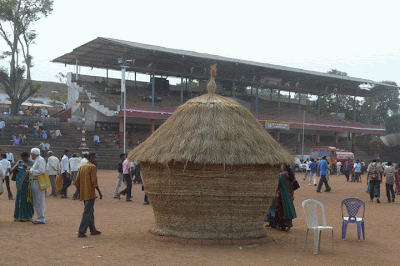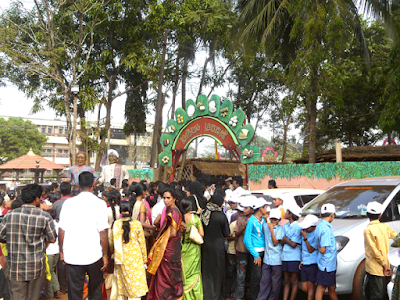
The word: PāD-dana
The Tulu word paD-dana appears to have had a complex origin, being possibly borrowed and adapted from the co-existing or pre- existing languages in the Karavali. Though it has been incorporated extensively in the Tulu usage, it does not sound like a original word of Tulu language. Amrita Someshwara in his work ‘Tulu PaDdana Samputa’ has also pondered over the issue.
The word paD-tana apparently is derived from old Kannada sources. The word ‘pāD(u)’ (=song) was commonly used in old Kannada. Later it became ‘hāDu’ in later Kannada, with p.> h transition. Similarly the suffix ‘–tana’ (=state of being; equivalent of English suffix ‘-hood’) is common usage in Kannada.(For, example siritana, baDatana, saNNatana, manetana etc). However, both these usages ‘pāD’ as well as ‘-tana’ are uncommon in Tulu. Therefore, it can be concluded that the word ‘paD-dana’ (or ‘paDtana’) was borrowed from old Kannada into Tulu. This is further supported by the reference in paDdanas that Panjurli came to Tulunadu from the Sahyadri Ghat areas, probably referring to ancient Kadamba Kingdom of Banavasi. Additionally, it may be noted that the name Varāhi (Varaha=Wild boar, Panjurli) has been applied to the River originating from Banavasi region.The old Kannada word pāDdana has been lost in the later versions of Kannada, probably as result of development of script and decrease of importance for the oral literature media.
pada
In Tulu phrase ‘pada panpini’ (= reciting a song), the word ‘pada’ is employed to represent an oral song. On the contrary, the word ‘pāDu’ (=song, as in old Kannada) or ‘pāTT’(=song, as in Tamil) is not in current usage in Tulu. Similarly, the suffix ‘-tana’ is not common in Tulu, except in words borrowed from Kannada. Thus the compound word ‘paD-tana’ (=act of singing) may have been borrowed from old Kannada along with the cult of Panjurli.
It is interesting to note that the word ‘pada’ evolved later to mean the word, especially in languages like Kannada that developed script in the due course. In current Kannada the equivalent of Tulu ‘pada’(=song) is ‘padya’(=poem).
Pārdana, pārteno
However there are some more equivalents of the word ‘paDdana’ in Tulu such as ‘pardana’ and ‘partena’ or ‘parteno’. However, these words were borrowed from ‘Gond’ and ‘Mundala’ languages. In Gondi language now prevalent in Vidarbha region of Maharastra, the word ‘pardan’ or ‘pardhan’ refers to tribal bards among Gonds.
Similarly, Mundala tribes use the word ‘partana’ or ‘partena’ or ‘parteno’ for the oral ballads.
The Gonds and Munda tribes were widespread in West Coastal region in the antiquity, probably before the arrival of tribes who spoke or introduced Tulu language in the Karavali region. Numerous ancient place names in the Karavali remain mute testimonies to the ancient existence of Gond and Munda tribes in the region.
PaTThana
There is an analogous Prakrit and Pali word known as ‘paTThana,’ whose original meaning has almost been lost. Some authors have surmised that it could be derived from the Sanskrit word ‘prārthana’. However, one of the Buddhist religious volumes in Pāli language has been known as ‘paTThana’, suggesting that it probably was in an oral ‘paD-dana’ form to begin with.The derived word 'paTTaN'(=reciting) has subsequently been absorbed in Hindi.
Prarthana
In the line of pardana- partana- paDdanas discussion, the Sanskrit word ‘prarthana’(=prayer) apparently has some relevance. Some authors have even suggested that the Sanskrit word ‘prarthana’ was the source or inspiration for the words partana- pardana- paDdanas. This seems unlikely since these tribal cultures were relatively more ancient and the Sanskrit was introduced in southern India more or less in the beginning of Christian Era.
Thus it seems likely that the coining of the Sanskrit word ‘prarthana’ was inspired from the tribal sequence of words namely : partana, pardana and paDdana.
Orature
Primitive cultures invented literature as creative pastimes long before the invention of script or the written word. The oral literature (‘orature’) was popular in Africa and other primitive centers of human evolution and dispersal.
Even the Vedas were a form of orature to begin with (ca.1700-500 BC), which were passed down the subsequent generations through recitation from memory. Contemporaneous Indian tribes like Mundas, Gonds and Others (who spoke Prakrit, Pali etc) had similar orature systems , like paD-dana ( or its regional variants such as partena, pardan or paTThan etc). This mode of folklore was also passed down the generations by sheer memory similar to Vedas. King Ashoka introduced the Brahmi script in India (ca. 300 BC) that revolutionized the documentation of literature. In many of the Indian languages, especially those with major royal patronage, scripts were introduced.
Note that the significance of oratures declined markedly in languages that developed popular scripts in due course like Sanskrit,Prakrit,Tamil,Kannada, etc as seen by the later disuse of the word (paDdana or its variants)in those languages.
Since some of the tribal languages of India may be older than Sanskrit, it may not be correct to consider that the preexisting languages borrowed some of these words from the Sanskrit. In reality, it may be the other way round.
Pardans (Gond bards, who apparently derived their names from singing pardan/paDdana), like Tamil Panans, acted like advisers to Kings, which subsequently introduced a new ministerial word pradhān (<.derived from 'pardan'). Similarly,the word 'pārteno' possibly led to coining of the Sanskrit word prārthana.
Sanskrit words, generally have been coined from word components that inherently carry the essence of meaning expressed in the final compound word. But if you split and analyze the words like 'prarthana' or 'pradhan', you may not get the root meanings tallying with the final meaning conveyed by the compound words.
With passage of time, we are unable to ascertain the original words that inspired formation of new words,and may be because of our inherent bias towards 'primitive' cultures.
®













